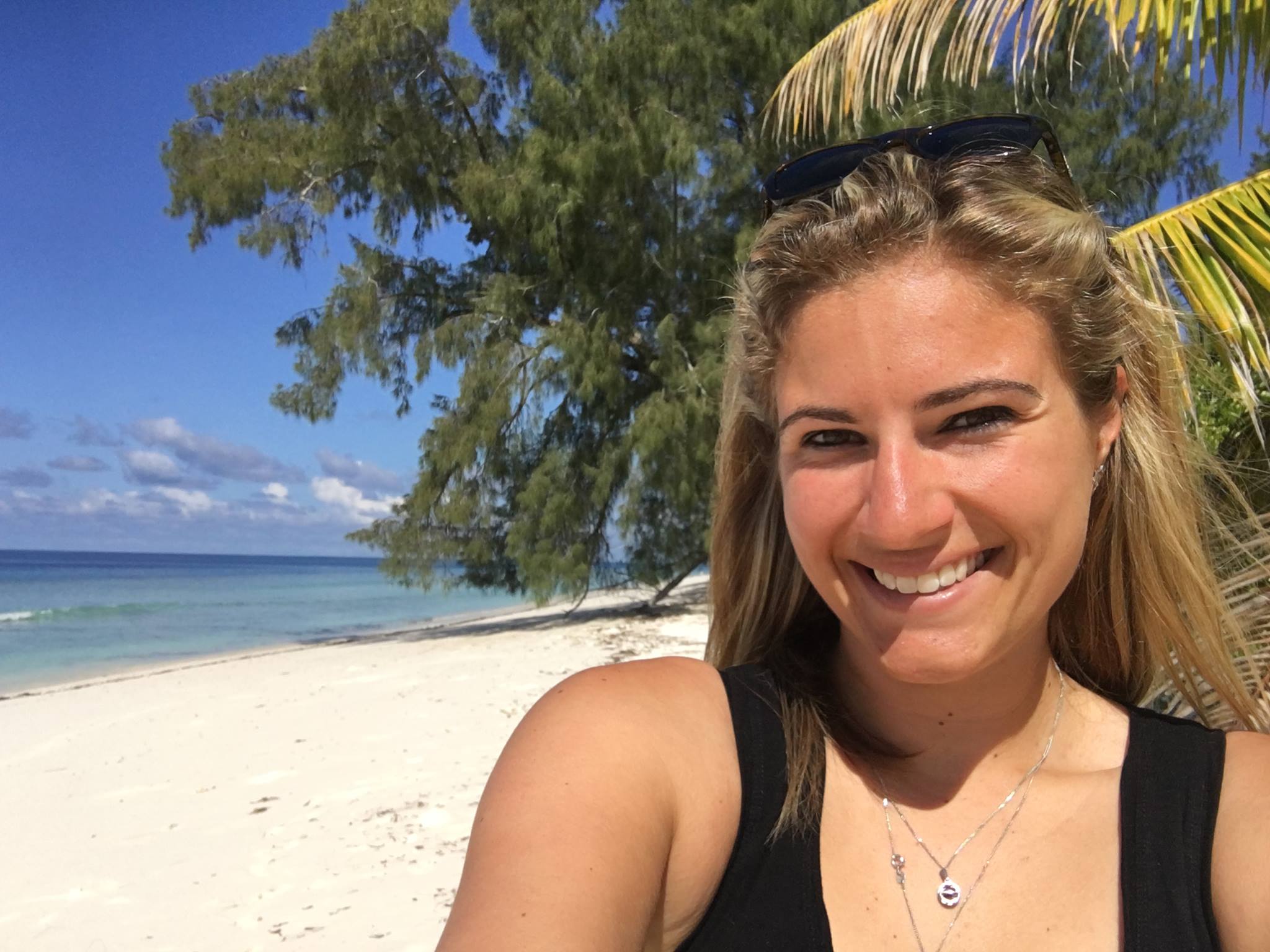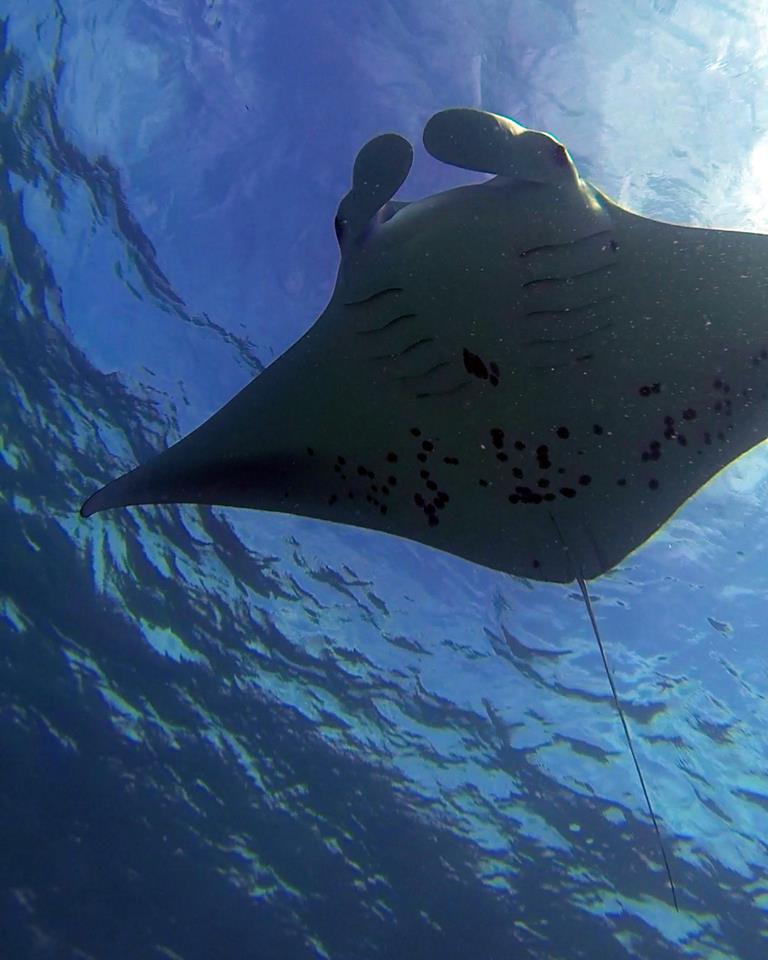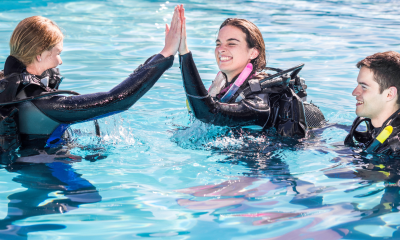News
Interview: Esther Jacobs talks to Lauren Peel, Seychelles Manta Ray Project

Lauren Peel has a BSc (Hons.) in Zoology from University of Western Australia. She is currently a PhD candidate in marine biology at University of Western Australia and project leader for The Manta Trust and Save Our Seas Foundation’s Seychelles Manta Ray Project.
EJ: How did you end up in science and research?
LP: I have always been in awe of the natural world and when I was five years old, my parents took me to the Ningaloo Reef in Western Australia. I could not get enough of snorkeling the reefs and exploring the intertidal pools to see what new creatures I could discover, and it was from that moment that my passion for the ocean and marine life was well and truly ignited. It wasn’t long before everyone knew what answer they would get when they asked me “What do you want to be when you grow up, Lauren?” – “A marine biologist!” I would say, with a huge grin on my face.
My fascination with the world around me drove me to complete my Bachelor’s degree in 2011 at the University of Western Australia, where I majored in zoology and chemistry. It was during my Honours year however, when I was working with Port Jackson sharks, that I discovered my love for all things elasmobranch. I knew then that I wanted to make a career out of studying these incredible animals and promoting their conservation through education, and I have been working towards achieving that goal ever since.
EJ: What’s your favourite species of elasmobranch?
LP: Tough question! In all honesty I do not think I can pick a favourite. I have been incredibly fortunate to work with a wide range of elasmobranch species and I have learnt so much from my experiences with each of them. One of the things that fascinates me the most about sharks and rays is the incredible amount of diversity that they display in everything from their body shapes to their life history strategies, so I think elasmobranchs collectively are my favourite.
EJ: You were a past field specialist for Oceans Research. Do you miss working with them?
LP: Yes I was, and it was a phenomenal two years that I spent working there. Although I do miss working with my colleagues and the white sharks, one of the best things about working in marine biology is the connectivity of researchers around the world – everyone knows everyone, and sometimes it feels like we are all from the same small town. This means that even though I am no longer based in Mossel Bay, I am still able to keep in touch with the scientists and staff who are there, visit them when I can, and plan future collaborations and research projects with them.
EJ: What was your favourite aspect of working with Oceans Research?
LP: There are countless things that I loved about working with Oceans Research, but my favourite thing would have to be working with the new interns each month and watching them learn the techniques that we used to study the diverse array of marine life present in Mossel Bay. From assessing the community structures present on the intertidal platforms, to tracking dolphins, and using photo-ID to count white sharks, no two days were ever the same and it was always exciting to share new experiences with the interns and research team.
EJ: What can you tell us about your past and / or current research?
LP: I first started studying elasmobranchs during my Honours year at the University of Western Australia where I studied the visual system of the Port Jackson shark (Heterodontus portusjacksoni). My research aimed to describe the structure and physiological function of the retina in this benthic shark species, and relate these findings to its behavior and ecology – it was so interesting. While I was completing my research project, I found out about the Oceans Research internship program and was an intern there for a month before returning as a Field Specialist for the next two years.
I am now working towards a PhD in Marine Biology; investigating the population dynamics, movement patterns and ecology of the Seychelles reef manta ray (Manta alfredi) population for the Seychelles Manta Ray Project with the support of the Save Our Seas Foundation, The Manta Trust, The Australian Institute of Marine Science, and The University of Western Australia, and I love it. The fieldwork for my research is based at the Save Our Seas Foundation’s D’Arros Research Centre, and it has been a fantastic and productive experience so far. For more information about this research, and lots of photographs and information about manta rays, people can follow the Project’s Facebook Page: www.facebook.com/SeychellesMantaRayProject.

EJ: What has been your most important scientific finding?
LP: Using a combination of acoustic and satellite telemetry, we are learning a lot about the movement and residency patterns of reef manta rays throughout the Amirantes Island Group of the Seychelles. Our acoustic tags are helping us to unravel the seasonal movement patterns of the mantas, and our satellite tags – the first to be deployed on any manta ray in the Seychelles – are showing us how far these animals travel and how they utilize the water column as they move. By pairing this information with the photo-identification component of the Seychelles Manta Ray Project, we are becoming better equipped to estimate the size of the Seychelles reef manta ray population as a whole.
EJ: Have there been any surprises?
LP: The Seychelles Manta Ray Project represents the first study of manta ray biology and ecology in the Seychelles, so we are learning new things about the reef manta population all the time. As individual manta rays can be identified by the unique pattern of spots that they have on their bellies, a key component of this project is to include as many people as possible in our research by encouraging them to submit photographs of the mantas they have seen throughout the country. The Seychelles is made up of 115 small islands spread across some ~1,400,000 km2, so we need as much help as possible to find the mantas and to record both who and where they are. It has been a fantastic experience networking with new people across the Islands, and it is always exciting when new manta rays are found, photographed, and added to our database.
EJ: What has been your biggest challenge?
LP: The biggest challenge for me so far was organizing and coordinating the first field trip for this project. Working on a remote island definitely has its difficulties and I had never organized an international field trip before. Needless to say, every hour of preparing paperwork, ordering equipment, and planning was worth it – I am still in awe of D’Arros Island and the manta rays that I am so lucky to work with and I’m now eagerly awaiting the next field season.
EJ: What’s more important, science or conservation?
LP: I think that science and conservation need to work hand-in-hand with each other in order to have the highest level of impact. Conservation strategies and outreach programs need to be scientifically-informed to ensure that resources are distributed effectively and that peoples’ efforts are directed to where they are most needed, and conservation programs can be a fantastic way of delivering scientific information to diverse groups of people on large scales. You can’t really have one without the other; they are both important.
EJ: What is the main goal of the Seychelles Manta Ray Project?
LP: The main aim of the Seychelles Manta Ray Project is to expand our understanding of the Seychelles reef manta ray population so that we can inform the development of targeted conservation strategies aimed at protecting their population in this region of the Indian Ocean. The results of this study will also be used to promote a more global view of the conservation needs of manta rays, which are currently listed as Vulnerable on the IUCN Red List of Threatened Species.
This research is made possible by generous funding contributions from the Save Our Seas Foundation (SOSF) and SOSF – D’Arros Research Centre, and through the support of the Ministry of Environment, Energy and Climate Change of the Republic of Seychelles.
EJ: Do you hope your research will aide in manta ray conservation?
LP: Very much so. One of the main reasons I decided to pursue a career in marine biology was because I wanted to share my passion for marine life and elasmobranchs with as many people as possible, and because I wanted to be able to contribute to the conservation of these incredible animals. Over the past 75 years, global manta ray populations have suffered drastic declines with numbers decreasing on average by 30% and losses as large as 80% being observed in some areas. These declines are caused by a number of anthropogenic factors, but are primarily driven by demand from the traditional Chinese medicine market for manta ray gill plates which are dried, put into a soup, and sold as ‘Peng yu sai’. It is believed that gill plates possess medicinal qualities that can benefit the consumer, yet there is no scientific evidence to support such claims.
Like most elasmobranchs, manta rays have an extremely slow reproductive rate – maturing at around 15-20 years of age and producing one pup every one to three (or even more) years – and this greatly compounds the impact of these fishing pressures. As I mentioned before, I believe that conservation and management strategies should be designed and implemented based on scientific evidence, and I hope the results of my research will allow for protective legislation – ideally at a national level – to be put in place for the manta rays of the Seychelles to ensure that their population can be protected long into the future.
EJ: What does conservation mean to you?
LP: To me, conservation means respecting the life and ecosystems around you, and making sure that future generations have the opportunity to experience all of the wonders of nature. It’s about promoting sustainability, and understanding that every decision we make in our life has an impact on the world around us.
EJ: Do you have any advice for anyone keen to follow in your footsteps?
LP: My advice would be to work hard, make the most of every opportunity you get given, and to network and volunteer whenever you can. Most importantly – be excited. The ocean is a massive and mysterious place and we still have so much left to learn about it, so never stop asking questions.
EJ: If the people who are reading this have their own photographs of manta rays, is there any way for them to get involved in manta ray research, too?
LP: Absolutely. If you have seen or photographed a manta in the Seychelles – or anywhere else in the world – you can contribute directly to the research and conservation of manta rays by submitting your images and sighting encounters through the Manta Trust’s online submission form. Alternatively, you can email your images to IDtheManta@mantatrust.org – but please don’t forget to let us know when and where you saw your manta(s).
The more information you provide, the more information we can give you on your encounter. We reply to each submission with details of the history of the manta ray that was photographed which includes information such as: the name of the manta, its ID number, its gender, its size, and where and when it has been sighted before. If you happen to spot a manta ray that has not been previously recorded, you can also choose its name.
Your help is greatly appreciated, so please take a few minutes to send us your manta images and/or sighting details and be proud of your role as a citizen scientist!
For information on Oceans Research and their internship opportunities visit www.oceans-research.com.
News
Book Review: Fire on Monroe Bravo by Fred Lockwood

Fire on Monroe Bravo is the latest book in the Jack Collier series by Fred Lockwood. Our story begins with our lead characters, Jack and Sandro, owners of Marine Salvage & Investigation Company, arriving on the Monroe Bravo Oil & Gas Platform in the North Sea. Having secured a contract for their vessel the MV Stavanger to act as support ship to the platform for TransGlobal Oil, our protagonists are on a celebratory visit.
However almost as soon as they arrive a series of explosions rock the platform, causing huge damage, loss of life and the very real danger of a massive human, ecological and financial disaster.

As the danger mounts for both our heroes and the surviving workers, Jack and Sandro will have to escape the inferno, all while trying to save the platform and the men still trapped unable to help themselves.
The disaster sets the scene for the unfolding story lines following the fate of the platform and our main characters, the police investigation into a suspected terrorist act and the actions of TransGlobal Oil as they attempt to navigate the pubic outcry and financial repercussions.
In his eighth book, Fire on Monroe Bravo, Fred Lockwood delivers an explosive thriller, with plenty of above and in-water drama, and our heroes fighting for survival, what more can you ask for?
We thoroughly recommend this read and look forward to the next in the series. For more information about his book series, you can check out the reviews of his previous books here on Scubaverse.
- Title: Fire On Monroe Bravo
- Author: Fred Lockwood
- ISBN: 979-8325324536
Available in a paperback version and for Kindle from Amazon and book stores.
Blogs
Alonissos: The complete diving destination (Part 1)

In June we were incredibly fortunate to be invited to dive in Alonissos, a small Greek Island in the Sporades island chain located in the North Aegean Sea. While I have long been a big fan of the Greek Islands as a great holiday destination, I had not had the opportunity to do any diving on previous visits and Mike and I were extremely excited to see what Alonissos had to offer both above and below the surface!

The Sporades are easily accessible via the airport in Skiathos (the first island in the chain), which is served by Jet2 flights from all major UK airports from May through October. Numerous ferries and charter boats make island hopping from Skiathos Town a breeze. After an hour boat ride, the picturesque port of Patitiri was a wonderful introduction to Alonissos, where we were met by our gracious hosts Kostas of Albedo Travel and Dias of Alonissos Triton Dive Center. Mike and I were delighted to be staying at the Paradise Hotel, aptly named for its stunning views over the sea and great location for walking to the waterfront.

Alonissos is beautifully situated in the National Marine Park of Alonissos and the Northern Sporades, the largest marine protected area in Europe. The surrounding seas offer fabulous marine life, including incredibly rare species such as the Mediterranean monk seal. They boast deep walls covered in gorgonians and sponges, stunning topography with caverns, swimthroughs and pinnacles, and the first accessible ancient shipwreck from 500BC!

In locations where historical sites have been reported, the waters are largely restricted, but with collaboration between government, underwater archeologists and dive centres, incredible underwater museums are being created for a truly unique diving experience. Alonissos is home to the first of these, the Ancient Shipwreck of Peristera Accessible Underwater Archeological Site. The chance to dive into history (along with reports of healthy reef life and amazing underwater topography) meant Mike and I were keen to get in the water.

Our introduction to the diving around Alonissos was at the Agios Georgios Pinnacles, in the channel between Alonissos and Skopelos. This fantastic site was named “The Chimney,’ and proved to have a huge amount to see. We got to a decent depth here (over 25m), and marvelled at a colourful reef wall with a wonderful swim through whose rocky walls were absolutely covered with life. As well as brilliant topography there was no shortage of macro life here. We saw numerous nudibranchs, five different species in total. The second dive at Mourtias reef nearby was a shallower dive along a nice wall with lots of crevices. Several moray eels and grouper called this site home. We enjoyed looking in the crevices for lobster and smaller benthic life, such as cup corals and tunicates.

Our itinerary allowed us two dives a day with afternoons left to explore the island with our hire car and evenings to enjoy the famous Greek hospitality. This proved to be a lovely mix of in-water and land based diversions.

The next days diving to the Gorgonian Gardens and Triton’s Cave was to be even better! These two stunning sites are nothing short of fabulous. The Gorgonian Gardens was a deep wall near to the Agios Georgios islands. The ever-present currents in this deep channel meant that the sea life was amazing … the namesake Gorgonian sea fans dotted the wall at a depth of 30 to 50 meters, getting ever larger the deeper we went. Above 30m was by no means less beautiful, with sponges, corals, scorpionfish, moray eels and some rare and colourful nudibranchs.

The second shallower dive of the day was to Triton’s Cave or the Cavern of Skopelos, on the east side of that island. The spectacular rock formations had wild striations both above and below the water making a truly epic topography. The cavern entrance was at 14m, and big enough for a buddy pair, winding up to 6m and passing two beautiful windows out into the blue. Emerging from the cavern, the light at the shallower depths and the incredible rock formations made for a fantastic gentle swimming safety stop and we all surfaced by the boat with massive grins.

Check out our next blog :Alonissos: The complete diving destination (Part 2)” to hear about our amazing dive on the 2500 year old Peristera Wreck!
Thanks to:
Alonissos Triton Dive Center https://bestdivingingreece.com/
Albedo Travel https://alonissosholidays.com/activities/
Paradise Hotel https://paradise-hotel.gr/
Alonissos Municipality https://alonissos.gr/en/
-

 Blogs2 months ago
Blogs2 months agoDiving With… Nico, Ocean Earth Travels, Indonesia
-

 News1 month ago
News1 month agoMurex Bangka Announce New Oceanfront Cottages & Beachfront Dining
-

 Blogs2 months ago
Blogs2 months agoA new idea in freediving from RAID
-

 Marine Life & Conservation1 month ago
Marine Life & Conservation1 month agoIceland issue millionaire whale hunter a licence to murder 128 vulnerable fin whales
-

 Marine Life & Conservation2 months ago
Marine Life & Conservation2 months agoThe Shark Trust Great Shark Snapshot is back
-

 News3 months ago
News3 months agoCharting New Waters; NovoScuba Goes Global with the Launch of their Revolutionary Dive Training Agency!
-

 Gear News1 month ago
Gear News1 month agoNew Suunto Ocean – a dive computer and GPS sports watch in one for adventures below and above the surface
-

 Marine Life & Conservation Blogs2 months ago
Marine Life & Conservation Blogs2 months agoBook Review: Plankton













